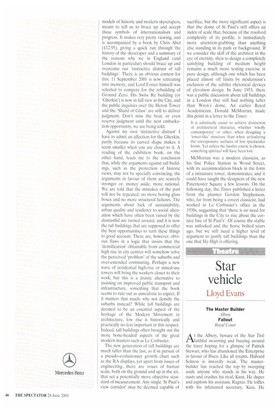Reach for the sky
Alan Powers
As classical columns and cornices were As
necessary to the architectural representation of high finance in the 1920s, so tall buildings are today. There may be a more rational argument to be made for squeezing maximum floor area from a given piece of ground than there was for spending extra money on Portland stone ornament, but we are looking in both cases at architectural preferences that have a strong basis in rhetorical gesture. It is a matter of branding — selling an image with a name tag (architect plus name of building) whose combined value can exceed that of its parts and justify the outlay.
The exhibition Sky High within the Royal Academy Summer Exhibition (until 10 August), curated by Norman Foster, is primarily an assemblage of architectural models of historic and modern skyscrapers, meant to tell us to brace up and accept these symbols of internationalism and progress. It makes very pretty viewing, and is accompanied by a book by Chris Abel (£12.95), giving a quick run through the history of the skyscraper and a summary of the reasons why we in England (and London in particular) should brace up and overcome our 'instinctive distrust of tall buildings'. There is an obvious context for this: 11 September 2001 is now retreating into memory, and Lord Foster himself was selected to compete for the rebuilding of Ground Zero. His Swiss Re building (or 'Gherkin') is now in full view in the City, and the public inquiries over the Heron Tower and the 'Shard of Glass' are still to deliver judgment. Don't miss the boat, or even reserve judgment until the next embarkation opportunity, we are being told.
Against my own 'instinctive distrust' I have to admit an affection for the Gherkin, partly because its curved shape makes it seem smaller when you are closer to it. A reading of the exhibition book, on the other hand, leads me to the conclusion that, while the arguments against tall buildings, such as the protection of historic views, may not be specially convincing, the arguments in favour of them are scarcely stronger or, money aside, more rational. We are told that the mistakes of the past will not be repeated: no more boring glass boxes and no more structural failures. The arguments about lack of sustainability, urban quality and tendency to social alienation which have often been raised by the distrustful are turned around, and it is now the tall buildings that are supposed to offer the best opportunities to turn these things to good account. There are, however, obvious flaws in a logic that insists that the 'densification' obtainable from commercial high rise in city centres will somehow solve the perceived 'problem' of the suburbs and over-extended commuting. Perhaps a new wave of residential high-rise or mixed-use towers will bring the workers closer to their work, but this is a drastic alternative to insisting on improved public transport and infrastructure, something that the book seems to rule out as unrealistic to expect. If it matters that much, why not densify the suburbs instead? While tall buildings are deemed to be an essential aspect of the heritage of the Modern Movement in architecture, low rise is historically and practically no less important in this respect. Indeed, tall buildings often brought out the more bone-headed aspects of the great modern masters such as Le Corbusier.
The new generation of tall buildings are much taller than the last, as if in pursuit of a pseudo-evolutionary growth chart such as the RA displays, yet apart from issues of engineering, there are issues of human scale, both on the ground and up in the air, that set a potentially more objective standard of measurement. Any single 'St Paul's view corridor' may be deemed capable of
sacrifice, but the more significant aspect is that the dome of St Paul's still offers an index of scale that, because of the resolved complexity of its profile, is immediately more attention-grabbing than anything else standing in its path or background. If we consider the skill of the architect in the eye of eternity, then to design a completely satisfying building of medium height remains a much more testing exercise in pure design, although one which has been placed almost off limits by modernism's exclusion of the subtler rhetorical devices of elevation design. In June 1953, there was a public discussion about tall buildings in a London that still had nothing taller than Wren's dome. An earlier Royal Academician, Donald McMorran, made this point in a letter to the Times: It is admittedly easier to achieve distinction of architectural character, whether 'wholly contemporary' or other, when designing a 'tower-like' structure than when articulating the unresponsive surfaces of less spectacular forms. Yet unless the harder course is chosen, something spiritual will have been lost.
McMorran was a modern classicist, as his fine Police Station in Wood Street, with its accommodation block in the form of a miniature tower, demonstrates, and it could have taught the designers of the new Paternoster Square a few lessons. On the following day, the Times published a letter from the planner Gordon Stephenson, who, far from being a covert classicist, had worked in Le Corbusier's office in the 1930s, suggesting that 'there is no need for buildings in the City to rise about the cornice line of St Paul's'. Of course the stable was unlocked and the horse bolted years ago, but we still need a higher level of argument to justify tall buildings than the one that Sky High is offering.



































































 Previous page
Previous page